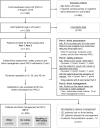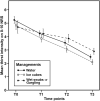Prevalence, risk factors, and optimized management of moderate-to-severe thirst in the post-anesthesia care unit
- PMID: 32999369
- PMCID: PMC7527446
- DOI: 10.1038/s41598-020-73235-5
Prevalence, risk factors, and optimized management of moderate-to-severe thirst in the post-anesthesia care unit
Abstract
Post-operative thirst is common and may cause intense patient discomfort. The aims of this retrospective study conducted in a high-volume post-anesthesia care unit (PACU) were as follows: (1) to examine the prevalence of moderate-to-severe post-operative thirst-defined as a numerical rating scale (NRS) score of 4 or higher, (2) to identify the main risk factors for moderate-to-severe post-operative thirst, and (3) to maximize the efficacy and safety of thirst management through a quality improvement program. During a 1-month quality improvement program conducted in August 2018, a total of 1211 adult patients admitted to our PACU were examined. Moderate-to-severe thirst was identified in 675 cases (55.8%). The use of glycopyrrolate during anesthesia was associated with moderate-to-severe thirst (71.7% versus 66.4%, respectively, p = 0.047; adjusted odds ratio: 1.46, p = 0.013). Following a safety assessment, ice cubes, room temperature water, or an oral moisturizer were offered to patients. A generalized estimating equation model revealed that ice cubes were the most effective means for thirst management-resulting in an estimated thirst intensity reduction of 0.93 NRS points at each 15-min interval assessment (p < 0.001)-followed by room temperature water (- 0.92/time-point, p < 0.001) and the oral moisturizer (- 0.60/time-point; p < 0.001). Patient satisfaction (rated from 1 [definitely dissatisfied] to 5 [very satisfied]) followed a similar pattern (ice cubes: 4.22 ± 0.58; room temperature water: 4.08 ± 0.55; oral moisturizer: 3.90 ± 0.55, p < 0.001). The use of glycopyrrolate-an anticholinergic agent that reduces salivary secretion-was the main independent risk factor for moderate-to-severe post-operative thirst. Our findings may provide clues towards an optimized management of thirst in the immediate post-operative period.
Conflict of interest statement
The authors declare no competing interests.
Figures
Similar articles
-
Early oral hydration on demand in postanesthesia care unit effectively relieves postoperative thirst in patients after gynecological laparoscopy: a prospective randomized controlled trial.BMC Anesthesiol. 2024 Aug 27;24(1):297. doi: 10.1186/s12871-024-02686-4. BMC Anesthesiol. 2024. PMID: 39192192 Free PMC article. Clinical Trial.
-
The Effect of Oral Water and Ice Popsicle Exposure on the Management of Thirst in the Immediate Postoperative Period.J Perianesth Nurs. 2025 Apr;40(2):356-364. doi: 10.1016/j.jopan.2024.05.013. Epub 2024 Sep 14. J Perianesth Nurs. 2025. PMID: 39283276 Clinical Trial.
-
Efficacy of an Ice Popsicle on Thirst Management in the Immediate Postoperative Period: A Randomized Clinical Trial.J Perianesth Nurs. 2018 Apr;33(2):153-161. doi: 10.1016/j.jopan.2016.03.009. Epub 2017 Mar 21. J Perianesth Nurs. 2018. PMID: 29580594 Clinical Trial.
-
The Effect of Cold Oral Applications in the Management of Postoperative Thirst: A Systematic Review.J Perianesth Nurs. 2024 Oct;39(5):907-914. doi: 10.1016/j.jopan.2023.11.014. Epub 2024 Mar 29. J Perianesth Nurs. 2024. PMID: 38556965
-
Cold pleasure. Why we like ice drinks, ice-lollies and ice cream.Appetite. 2013 Dec;71:357-60. doi: 10.1016/j.appet.2013.09.011. Epub 2013 Sep 21. Appetite. 2013. PMID: 24060271 Review.
Cited by
-
Timing of early water intake post-general anaesthesia: a systematic review and meta-analysis.BMC Anesthesiol. 2024 Apr 9;24(1):135. doi: 10.1186/s12871-024-02520-x. BMC Anesthesiol. 2024. PMID: 38594662 Free PMC article.
-
Incidence and Associated Factors of Postoperative Undesirable Anesthetic Outcomes Among Surgical Patients at Referral Hospitals in Amhara Region, Ethiopia: A Multi-Center Study.Patient Relat Outcome Meas. 2023 May 16;14:137-152. doi: 10.2147/PROM.S403697. eCollection 2023. Patient Relat Outcome Meas. 2023. PMID: 37215184 Free PMC article.
-
Prevalence, risk factors, and treatment methods of thirst in critically ill patients: A systematic review and meta-analysis.PLoS One. 2025 Mar 18;20(3):e0315500. doi: 10.1371/journal.pone.0315500. eCollection 2025. PLoS One. 2025. PMID: 40100895 Free PMC article.
-
Thirst experience and nursing needs in older patients after general anesthesia for gastrointestinal surgery: A qualitative study.World J Gastrointest Surg. 2025 May 27;17(5):105239. doi: 10.4240/wjgs.v17.i5.105239. World J Gastrointest Surg. 2025. PMID: 40502508 Free PMC article.
-
Penehyclidine hydrochloride for treating postoperative nausea and vomiting after laparoscopic bariatric surgery: a double-blinded randomized controlled trial.BMC Anesthesiol. 2023 Apr 24;23(1):135. doi: 10.1186/s12871-023-02078-0. BMC Anesthesiol. 2023. PMID: 37095439 Free PMC article. Clinical Trial.
References
-
- Bauer M, Bohrer H, Aichele G, Bach A, Martin E. Measuring patient satisfaction with anaesthesia: Perioperative questionnaire versus standardised face-to-face interview. Acta Anaesthesiol. Scand. 2001;45:65–72. - PubMed
-
- Walker EMK, et al. Patient reported outcome of adult perioperative anaesthesia in the United Kingdom: A cross-sectional observational study. Br. J. Anaesth. 2016;117:758–766. - PubMed
-
- Conchon MF, Nascimento LA, Fonseca LF, Aroni P. Perioperative thirst: An analysis from the perspective of the Symptom Management Theory. Rev. Esc. Enferm. USP. 2015;49:122–128. - PubMed
-
- Garcia AK, Fonseca LF, Aroni P, Galvao CM. Strategies for thirst relief: Integrative literature review. Rev. Bras. Enferm. 2016;69:1215–1222. - PubMed
-
- Salata RA, Verbalis JG, Robinson AG. Cold water stimulation of oropharyngeal receptors in man inhibits release of vasopressin. J. Clin. Endocrinol. Metab. 1987;65:561–567. - PubMed
Publication types
MeSH terms
Substances
LinkOut - more resources
Full Text Sources
Medical



